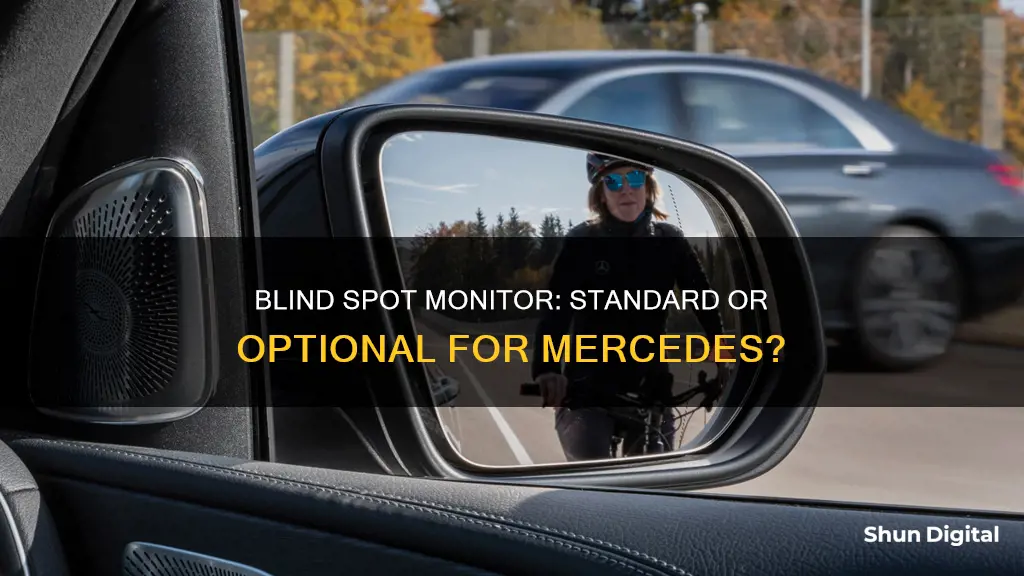
Blind spots are areas of a vehicle that are obstructed from the driver's field of vision, and checking them is essential to avoid collisions. However, this can be challenging, especially on busy highways or winding roads. To address this issue, Mercedes-Benz offers a Blind Spot Monitoring system, also known as Active Blind Spot Assist, which uses sensors and cameras to detect vehicles or obstacles in the driver's blind spot. This technology provides both visual and auditory alerts, enhancing the driver's awareness and reducing the risk of accidents during lane changes. The system is available on various Mercedes-Benz models, including the C-Class, E-Class, S-Class, GLC, GLE, and GLS, adding an extra layer of safety and convenience.
| Characteristics | Values |
|---|---|
| Name | Active Blind Spot Assist |
| Function | Constantly monitors an area of up to 10 feet behind and immediately adjacent to your vehicle. Alerts the driver with visual and auditory cues if a vehicle is detected within the blind spot area. |
| Visual Alerts | A red triangle warning indicator appears in the corresponding exterior side mirror. |
| Auditory Alerts | An audible alert sounds if the driver signals a lane change while a vehicle is in the blind spot. |
| Steering Assistance | Can apply corrective steering actions to keep the vehicle in its intended lane if the driver continues to attempt a lane change despite warnings. |
| Activation Speed | Active at speeds above 18 mph. |
| Models | C-Class, E-Class, S-Class, GLC, GLE, GLS, and many Mercedes-AMG® models. |
What You'll Learn

How does the Mercedes-Benz Blind Spot Monitor work?
The Mercedes-Benz Blind Spot Monitor is a crucial safety feature that helps detect vehicles in your blind spots, enhancing your awareness by providing visual and auditory alerts. This system significantly reduces the risk of accidents during lane changes.
The Blind Spot Monitor uses radar sensors to scan the areas alongside and behind your vehicle. When a vehicle enters your blind spot, the system illuminates a warning light on the appropriate side mirror. If you signal a lane change while a vehicle is in your blind spot, the system will also emit an audible alert to prevent a potential collision.
The Blind Spot Monitor is available on several prestigious Mercedes-Benz models, including the C-Class, E-Class, S-Class, GLC, GLE, and GLS. Many Mercedes-AMG® models also feature this safety feature.
There are different types of blind spot assist systems available:
- Visual indicator: This system uses a light or icon in the side mirror to indicate a vehicle in your blind spot.
- Audio indicator: This system emits a beeping or chirping sound to alert you about vehicles in your blind spot.
- Vibration indicator: Some cars have a system that makes the steering wheel vibrate to warn you about vehicles in your blind spot.
- Active system: This advanced system can automatically apply the brakes to prevent you from changing lanes into a vehicle in your blind spot.
It's important to note that while the Blind Spot Monitor provides valuable assistance, you should continue to manually check your blind spots instead of relying solely on this system.
Monitoring VRAM Usage: MSI Afterburner Guide
You may want to see also

What are the key benefits of a Blind Spot Monitor?
Blind Spot Monitoring (BSM) is a crucial safety feature that helps detect vehicles in a car's blind spots. Here are some key benefits of this technology:
Enhanced Safety and Accident Prevention
BSM provides drivers with visual, auditory, and even tactile alerts about vehicles in their blind spots, significantly reducing the risk of accidents, especially during lane changes. This early warning system gives drivers more time to respond and make safer driving decisions.
Increased Driving Awareness
By constantly monitoring areas that are hard to see, BSM enhances a driver's awareness of their surroundings. This is especially beneficial on crowded highways and busy roads, where checking blind spots manually can be challenging and dangerous.
Reduced Stress and Improved Confidence
Driving in heavy traffic or on unfamiliar roads can be stressful. BSM relieves some of this stress by providing an extra layer of safety and helping drivers feel more confident. Passengers will also feel safer, knowing that the risk of accidents is reduced.
Autonomous Intervention
Some advanced BSM systems can even take autonomous action to prevent accidents. These systems may provide subtle steering or braking input to keep drivers from changing lanes into another vehicle, ensuring that you stay in your lane even if you don't notice the alerts.
Compatibility with Other Systems
BSM often pairs with other driver-assistance technologies, such as rear cross-traffic alert (RCTA) and lane departure warning systems. This integration provides comprehensive protection from side and rear collisions, further enhancing safety on the road.
While BSM is a valuable safety feature, it is important to remember that it should be used as an aid and not a replacement for safe driving practices. Drivers should still use their turn signals, check their mirrors, and look over their shoulders when changing lanes.
Monitoring Router Bandwidth Usage: A Step-by-Step Guide
You may want to see also

How do I know if my Mercedes has Blind Spot Monitoring?
Blind Spot Monitoring (BSM) is a clever safety feature that helps drivers be more aware of their surroundings. It uses sensors to detect other vehicles in your blind spots, which are areas where you can't see with your mirrors. When the system senses a vehicle in your blind spot, it alerts you with either visual or audio warnings before you try to change lanes. This way, you can avoid potential collisions and drive more safely.
There are a few ways to know if your Mercedes has Blind Spot Monitoring:
- Check your vehicle's specifications. Many Mercedes-Benz models include Blind Spot Monitoring as a standard or optional feature, so it should be listed in the specifications.
- Look for warning indicators on the side mirrors. The Blind Spot Monitoring system typically illuminates a warning light on the appropriate side mirror when a vehicle enters your blind spot.
- Check your owner's manual. The owner's manual should provide detailed information about your vehicle's features, including any safety systems such as Blind Spot Monitoring.
- Contact your local Mercedes-Benz dealership. They will have the knowledge and resources to help you determine if your specific model is equipped with Blind Spot Monitoring.
It's important to note that while Blind Spot Monitoring can provide valuable assistance, you should not rely solely on this system. Continue to check your blind spots manually and stay alert while driving.
Simple Ways to Check Your Monitor's Resolution
You may want to see also

What is Active Blind Spot Assist?
Active Blind Spot Assist is a groundbreaking safety feature developed by Mercedes-Benz to help drivers stay alert and aware of obstacles in their blind spots. It uses a combination of sensors and cameras to constantly monitor an area of up to 10 feet behind and immediately adjacent to the vehicle. This system is designed to assist drivers when travelling on crowded highways or winding roads, where checking blind spots can be challenging and take your eyes off the road.
When a vehicle enters your blind spot, Active Blind Spot Assist alerts you by displaying a red triangle warning indicator in the corresponding exterior side mirror. This system is active at speeds above 18 mph. If you fail to notice this visual warning and signal for a lane change, the warning light will flash and an audible alert will sound. Additionally, if you continue to attempt the lane change despite the warnings, Active Blind Spot Assist can apply corrective steering actions to keep you safely in your intended lane.
Active Blind Spot Assist is available on almost all Mercedes-Benz models and has been shown to prevent thousands of injuries and deaths each year. While this system provides valuable assistance, it is important to remember that you should still manually check your blind spots as well.
Attaching the Asus VG278Q to a Monitor Arm
You may want to see also

How does Active Blind Spot Assist work?
Active Blind Spot Assist is a groundbreaking feature developed by Mercedes-Benz to help keep drivers alert and aware of obstacles in their blind spots. This advanced technology uses sensors and cameras to constantly monitor an area of up to 10 feet behind and adjacent to the vehicle. When a vehicle enters the blind spot, a red triangle warning indicator appears in the corresponding exterior side mirror. Active Blind Spot Assist is activated at speeds above 18 mph.
If the driver fails to notice the visual warning and signals a lane change, the warning light will flash, and an audible alert will sound. If the driver continues to attempt the lane change despite the warnings, Active Blind Spot Assist can intervene by applying corrective steering actions to keep the vehicle in its intended lane.
This system is available on nearly all Mercedes-Benz models and has been shown to enhance safety. Experts estimate that thousands of injuries and hundreds of deaths are prevented each year due to the widespread adoption of blind-spot monitoring systems. While this technology provides valuable assistance, drivers should continue to manually check their blind spots instead of relying solely on this system.
The Blind Spot Assist feature can sometimes become inoperative, with some users reporting issues with sensors and connections. In some cases, drying out or warming up the sensors has been reported to fix the issue.
Cleaning Your LCD Monitor: A Step-by-Step Guide
You may want to see also
Frequently asked questions
The Blind Spot Monitor is a safety feature that helps detect vehicles in your blind spots, enhancing your awareness by providing visual and auditory alerts. This significantly reduces the risk of accidents during lane changes.
The system uses radar sensors to scan the areas alongside and behind your vehicle. When a vehicle enters your blind spot, a warning light illuminates on the corresponding side mirror. If you signal a lane change, an audible alert will also sound to prevent a potential collision.
Many Mercedes-Benz models include Blind Spot Monitor as a standard or optional feature. Check your vehicle's specifications or look for warning indicators on the side mirrors. You can also refer to your owner's manual or contact your local Mercedes-Benz dealership for assistance.
The Blind Spot Monitor adds an extra layer of safety and convenience, especially in heavy traffic and on highways where side collisions are more likely to occur. By providing timely warnings, it helps you make safer driving decisions and reduces the risk of accidents.







